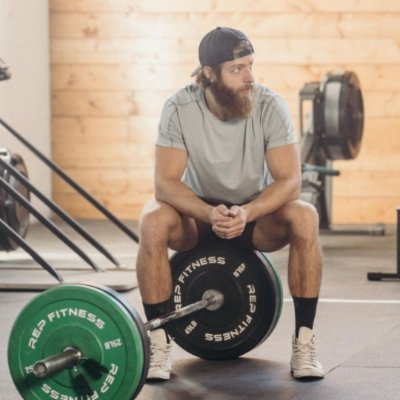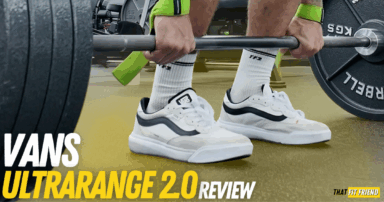The pull-up is an upper body right of passage. Few lifters can’t remember the first time they ever performed a pull-up, especially if it was a milestone they were working toward when they started their lifting journey.
In my coaching opinion, few upper body exercises compare to the pull-up when the goal is building back strength and size. Not to mention, you can get an awesome grip boost with pull-ups. Great pull-ups start from your setup.
How To Do Pull-Ups
Step 1: Grip a bar with the hands wider than shoulder-width apart
To start your pull-up, you’ll want to establish a strong. Your grip can be a make or break with pull-ups as it will heavily dictate how you sequence the arms and upper body when performing reps.
Generally speaking, you’ll want a grip width that is a little wider than your shoulder width. This will usually feel the most natural and strongest for most lifters.
You’ll want to grip the bar so your knuckles are facing upwards. You do NOT want to crank the wrists while performing reps, think about gripping with the hand but don’t flex the wrists.
Step 2: Get Set and Slightly Brace
Once you’ve established your grip, you’ll then begin your reps from a dead hang position. You can let your feet hang straight down or flex the knees and cross the feet. I’ll do this and switch my legs halfway through sets.
Before you start pulling yourself upwards, you’ll want to slightly brace as this will help prep the muscles and core for the stress you’re about to put on them.
A light brace can also be useful for maintaining good form and a consistent pull-up body path. As you do more reps, you’ll learn how much of a brace you need.
Remember, breathe as you perform your reps, and don’t brace too hard to where you can’t breathe at all.
Step 3: Pull yourself up, drive elbows down
Once you’re set, you’ll start pulling up to the bar. If you’re just starting out you may only be able to get your chin to bar level of just over it, and that’s totally okay.
As pull-ups get more routine, the height at which you can pull yourself up will naturally increase. For example, I typically pull myself up to about chest height, but this is not necessary to gain the benefits of pull-ups.
A cue that I like to use for pull-ups is to think about, “driving the elbows into the floor”. This cue is useful because it can help lifters with the vertical pull mechanics and it can help prevent chicken winging the elbows.
Step 4: Lower yourself in a controlled manner
Once you’ve hit the end range of motion in which you can pull yourself up, you’ll start the eccentric also referred to as the lower portion of this exercise.
The eccentric is important because it can help you accrue more time under tension which can have positive carryovers for hypertrophy and strength. When lowering yourself down the body should stay relatively inline versus swaying heavily.
Once you’ve lowered yourself down in a controlled manner, set and brace accordingly to repeat this for yourself following reps.
Coach Jake’s Pull-Up Thoughts
The pull-up is one of my favorite upper body exercises and I know I’m not alone in saying that. For most lifters, the pull-up is a staple in their workout program especially back and upper body days.
There are tons of benefits that come along with performing more chin-ups and pull-ups. The pull-up tends to be the slightly tougher exercise and it does a great job at building upper body strength and mass.
If you’re on the quest of conquering the pull-up, below is how I’d coach and cue you if were working together doing a personal training session.
What Muscles Do Pull-Ups Train?
Primary Muscles
- Latissimus Dorsi
- Biceps Brachii
- Trapezius
- Rhomboids
Secondary Muscles
- Forearm Muscles
- Deltoids
- Core Muscles
- Pectoral Muscles
The pull-up is a vertical pulling exercise that is popular to perform for building the lats and upper back. This exercise trains a range of muscles and can be used as a milestone and progress exercise.
Primary Pull-Up Muscles (Expanded)
Primary Muscle 1: Latissimus Dorsi
Why Train the Lats: The latissimus dorsi, also called the “lats,” are crucial for upper body strength and posture. The lats will play a role in most upper body movements and are involved in vertical and horizontal rowing patterns.
Benefits of Strong Lats: Stronger lats will enhance and improve shoulder and back stability. This will have carryover to your overall gym performance, daily life, and activities like sports.
Pull-Up Impact: Pull-ups can be a fantastic exercise exercise for targeting the lats. By focusing on lat growth you can increase your back’s width and improve your “v-taper” which is the width of your back to your waist’s width.
Primary Muscle 2: Biceps Brachii
Why Train the Biceps: Biceps play a crucial role in arm flexion and they’ll have a heavy hand in overall arm strength. Whether you’re lifting or carrying something the biceps will be active and assisting.
Benefits of Strong Biceps: Strong biceps improve lifting abilities, sports performance, and arm aesthetics. They can also play a role in stabilizing the arms when doing various activities such as playing with your kids, lifting groceries, and holding things.
Pull-Up Impact: While primarily thought of as a back exercise, pull-ups also significantly work the biceps. When reaching and pulling the body vertically the biceps brachii will be heavily at work creating arm flexion.
Primary Muscle 3: Trapezius
Why Trap the Traps: The trapezius muscles support the neck and upper back. Our traps play a role in our posture and will influence how we move and perform during different activities. It’s never a bad idea to have a stronger upper back and neck.
Benefits of Strong Traps: A strong trapezius helps in neck mobility and shoulder elevation. The traps also play a role in shoulder blade retraction, so when rowing and pulling things to us for example, strong traps can assist.
Pull-Up Impact: Pull-ups engage the trapezius, especially in the upper region as you vertically pull yourself to the bar. This can have carryover to your overhead pulling strength and stability.
Primary Muscle 4: Rhomboids
Why Train the Rhomboids: Rhomboids stabilize the shoulder blades which is incredibly important for rowing tasks and general stability of the back. When we row, the rhomboids will help pull things towards the body.
Benefits of Strong Rhomboids: Strengthening the rhomboids supports better posture and will assist with rowing-focused tasks. It can also play a role in our arm’s stability when holding things tight to the body along with pulling and pushing things away from the body.
Pull-Up Impact: Pull-ups require rhomboid engagement for effective movement mechanics, especially during the first portion of the pull-up. The rhomboids will assist in scapular retraction and elevation.
Pull-Up Benefits
There are pull-up benefits and that’s why this exercise can be so awesome to perform routinely. Generally, there are three key benefits that I’ll share with clients when explaining why we’re doing pull-ups.
Benefit 1: Train Multiple Muscles At Once
The first benefit of doing more pull-ups is the fact that they can hit so many muscles at once. Whether you’re pressed for time or just want to train the upper body in full, the pull-up can be a great option to explore.
As highlighted above, you’ll be able to train handfuls of muscles on the arms and back, plus, you’ll get a passive core and upper pec benefit. This is also why pull-ups can be so awesome when traveling and you’re wanting to maintain strength and upper body mass.
For beginners, pull-ups can help build a nice foundation of muscle on the upper body and it’s a movement pattern that I suggest most learn and get comfortable with as they dive deeper into their lifting journey.
For intermediate and advanced lifters, the ability to do weighted pull-ups is a fantastic way to blast through upper body plateaus and build unreal vertical pulling strength.
Benefit 2: Great Milestone Exercise
Another underappreciated pull-up benefit is that they can be a great milestone exercise to track both physical and mental progress in the gym. When you’re just starting out your lifting journey, it may feel impossible to do a pull-up under your own power.
However, over time as you work and progress in the gym, the pull-up can be a great exercise to use to track progress. Why is this? You can easily gauge strength gains by the range of motion you can move through with the clear goal of getting your chin to the bar.
On top of this, since the pull-up trains so many muscles at once, it’s a good exercise to use to understand how much you’ve grown across the board for multiple muscles. You’ll know your forearms, back, and arms have all gotten stronger when doing your first pull-up.
Benefit 3: Carryover to Real-Life Activities and Sports
The final benefit of performing more pull-ups in your workout program is that they can carry over to real-world activities and sports. For example, you no longer have to stress activities like rock climbing or doing housework that require reaching and pulling.
Now obviously, not all of us are rock climbing regularly and that example may be lost on you, but the point is that a stronger upper body will never leave you feeling like you “can’t” do activities that are brought to you.
In the context of sports, it’s never a bad idea to have a stronger back, grip, and overall upper body strength. Whether you’re playing hockey, lacrosse, basketball, football, or even soccer, having some foundational upper-body strength will never let you down.
Pull-Up Mistakes to Avoid
When performing pull-ups more regularly, there are two mistakes that I’ll typically see beginners make with this exercise. There are obviously more mistakes that you can make outside of these two, but these are the most common.
Mistake 1: Gripping Too Narrow Or Wide
As touched on in the how-to section above, your pull-up grip can be huge for ensuring you’re getting the most out of your pull-up reps. While there’s no one perfect place to grip a pull-up bar you will want to avoid the extremes.
For example, anywhere from shoulder to slightly wider than shoulder width is a good bet. If you’re gripping excessively wide or narrow then you might start cutting into your range of motion which will limit overall muscle gains.
On top of this, gripping too wide and too narrow can leave you in disadvantaged positions which can make reps feel uncomfortable or harder than they need to be. We want to position ourselves to let the muscles move in ranges of motion they work best in.
Mistake 2: Swaying Too Much
Another mistake that I tread lightly about is swaying a little too much. When you’re learning pull-ups, it’s normal to sway a lot as you build strength, learn, and get comfortable with this exercise.
This is not the context I’m talking about. The swaying mistake you want to avoid is having this present during every single pull-up rep even after you’re able to perform a few reps in a row. I’d suggest starting with the legs straight if you’re struggling with this.
You ideally want to find a body position that allows you to remain relatively consistent with your movement as this can help you perform stronger and more consistent reps. Plus, swaying can take away from your overall energy and effort during sets.
Beginner Pull-Up Progressions
If you’re just beginning your pull-up journey and reps feel impossible don’t worry. With the right beginner pull-up progressions and skill-focused sessions, I’m confident you’ll learn this exercise in a timely manner.
Keep in mind that everyone learns at different rates and there are countless ways to approach getting your first pull-up rep. The following is what I like to use with my clients, but it’s not the end-all-be-all approach.
Beginner Pull-Up Program
- Week 1 Static Holds: For week 1, you’ll perform pull-ups twice during the week. Spread out the days by 2-3 days and what you’ll do is jump to the top of your pull-up and do 3-5 sets of static holds. Try to hold yourself above the bar for as long as you can for each set.
- 2x a week, 3-5 sets of static holds.
- Week 2-3 Slow Eccentrics: For weeks 2-3, you’ll do this twice a week, and you’ll still jump to the top of your reps and ideally hold for 1-2 seconds and settle, then you’ll focus on lowering yourself down slowly counting to 3-5 seconds for 3-5 sets.
- 2x a week, 3-5 sets of 3-5 second eccentrics (lowering)
- Week 4-5 Baby Pull and Eccentrics: For weeks 4-5, you’ll perform this flow twice a week and you’ll start implementing concentric (pulling range of motion) with eccentrics. You’ll perform 2-3 reps for 3-5 sets. Ideally, you’ll want to start feeling what it’s like to pull yourself during these weeks. Work to get as much range of motion as possible, then jump to your eccentric.
- 2x a week, 2-3 reps of small pull-ups with a jump to a slow eccentric for 3-5 sets.
- Week 6+ Testing and Repeating: On week 6, you’ll attempt your first pull-up! If you’re still unable to accomplish a full rep, don’t stress. That just means we get to repeat the above and use a little more strategy.
Following week 6, if you’re still unable to complete your pull-up reps, try implementing the following accessory on top of the pull-up focused work provided above for weeks 1-5.
If you’re struggling with your grip strength, then you’ll want to focus more on doing holds both at the top and at the bottom with the arms fully extended. Grip strength with the pull-up is specific so spend more time getting comfortable holding your body weight.
If you’re struggling midway up on reps, try adding more direct lat work into your workout program. Dumbbell rows, Pendlay rows, and lat pulldowns can all be great additions to boost your lat strength.
Try not to get discouraged if it feels impossible to complete pull-up reps, I know, easier said than done. With consistent work and effort, you’ll get there — I promise.
I have never once seen a lifter not accomplish pull-ups when they put their mind to it. We’re all on different journies working on different timelines.
Frequently Asked Questions (FAQ)
Q:What is a pull-up?
Q:How do you pull-up for beginners?
Q:Why are pull-ups so difficult?
Takeaway Thoughts
The pull-up is a fantastic upper body exercise for building the lats, upper back, and arms. In many ways, the pull-up is what many consider a right of passage for displaying good levels of upper body strength.
If you’re just starting out your lifting journey and pull-ups feel impossible, hang in there. With effort, consistency, strategy, and coaching, you’ll be able to tackle pull-ups with no problem.
If you have additional questions about pull-ups, drop a comment below or reach out to me via Instagram (@jake_boly or @that_fit_friend).


















Add a Comment